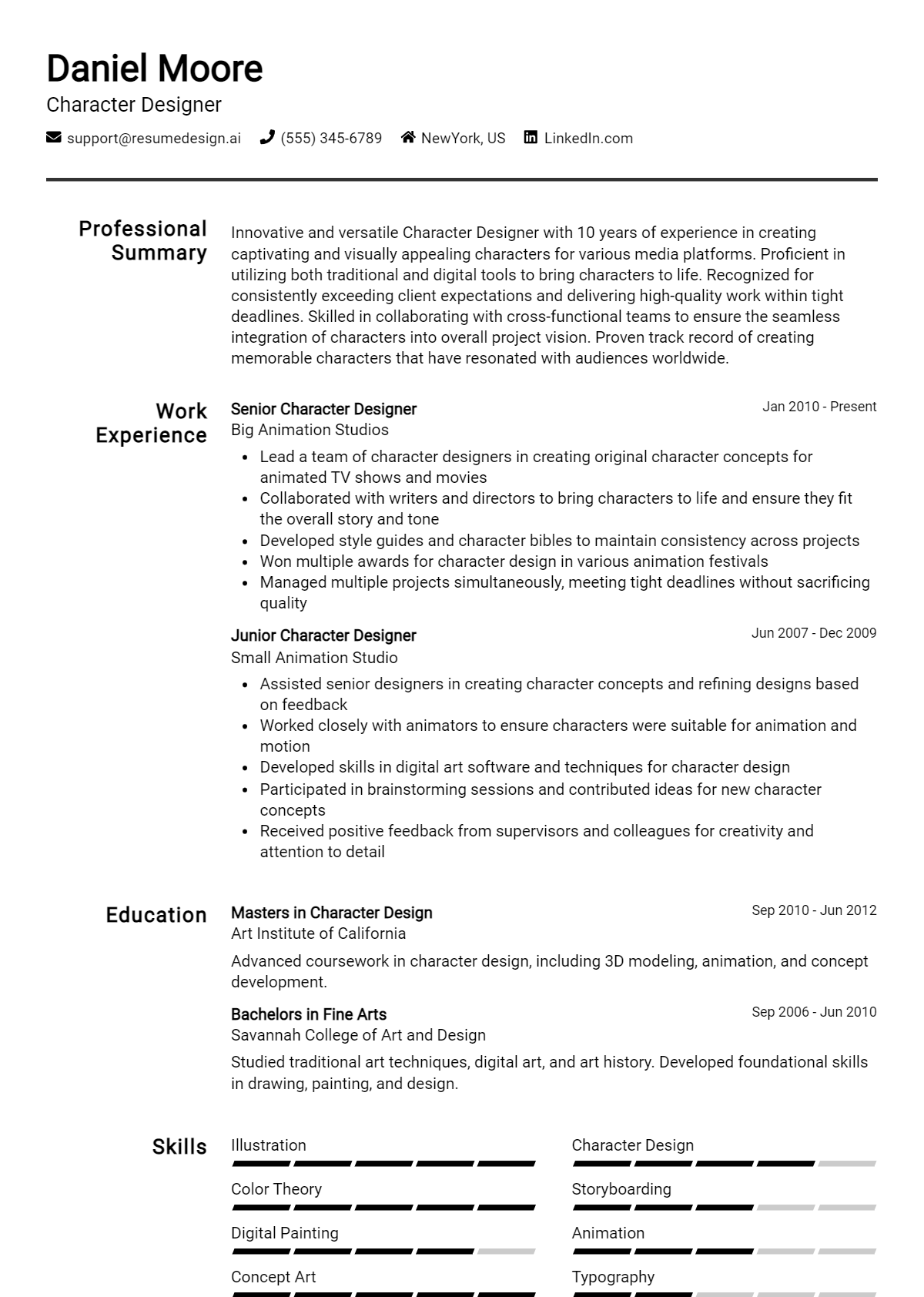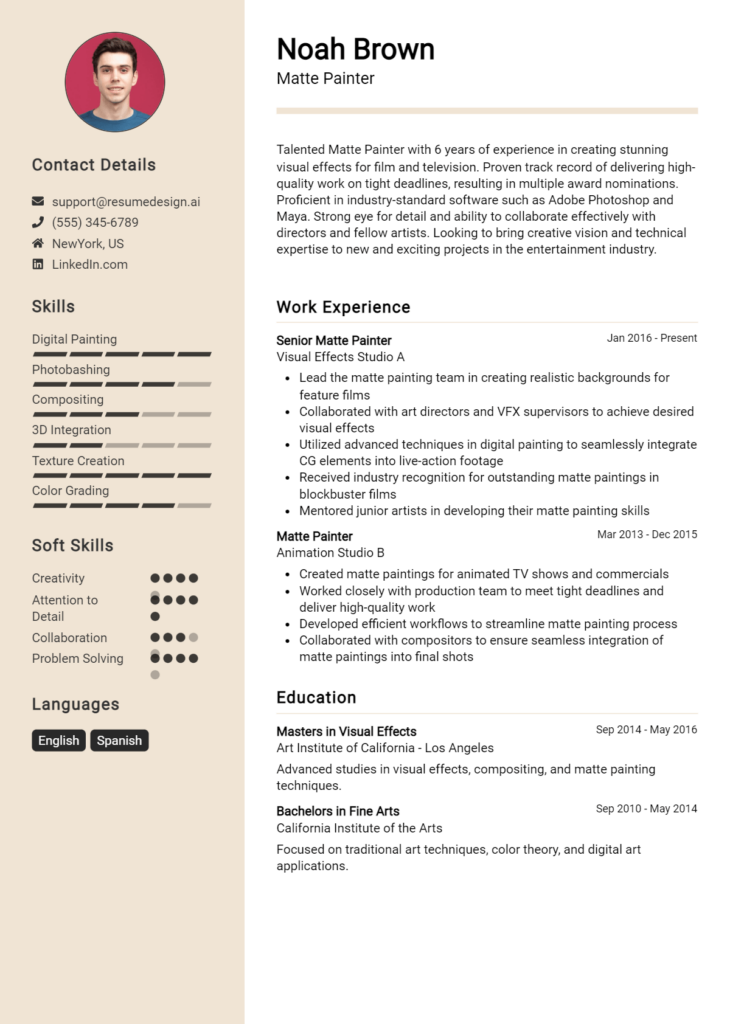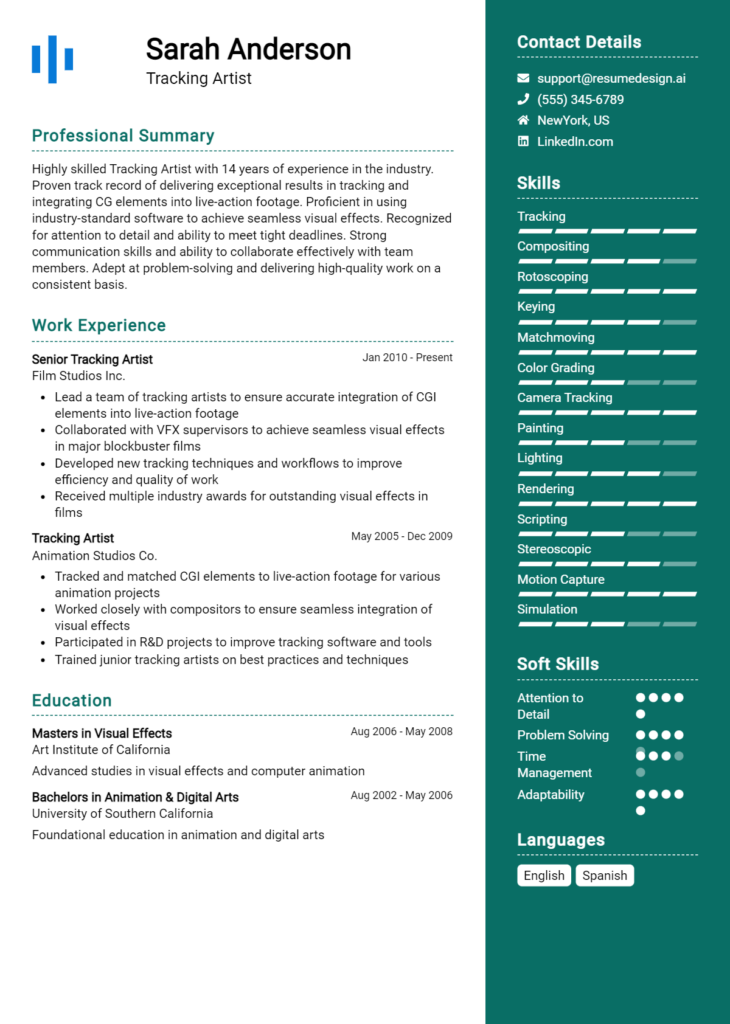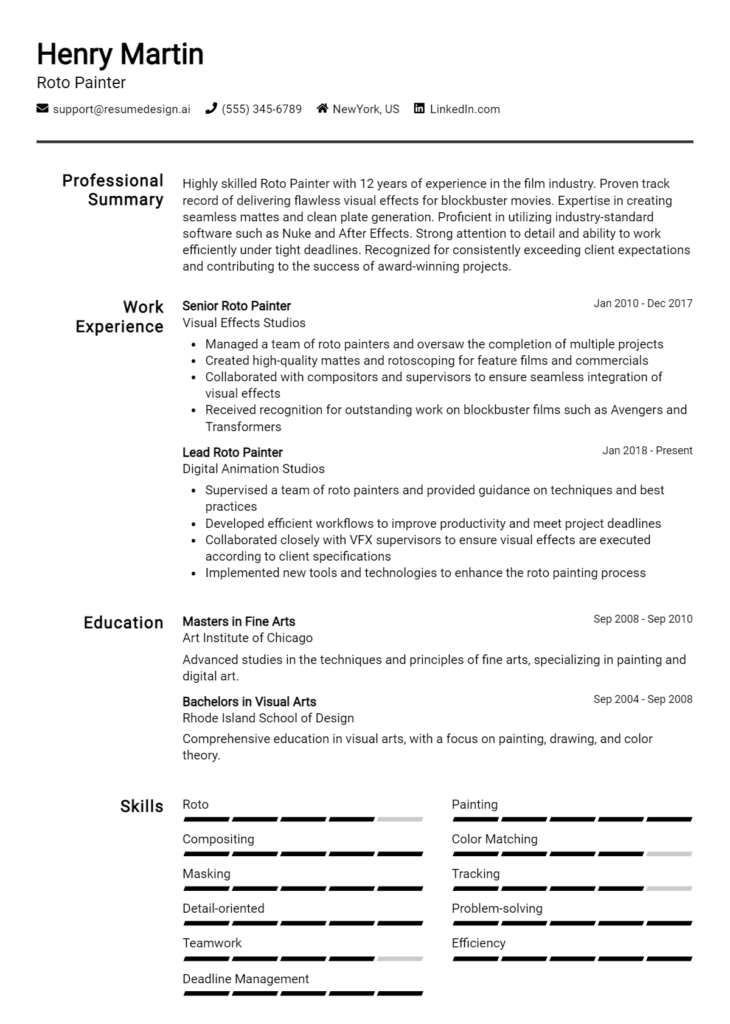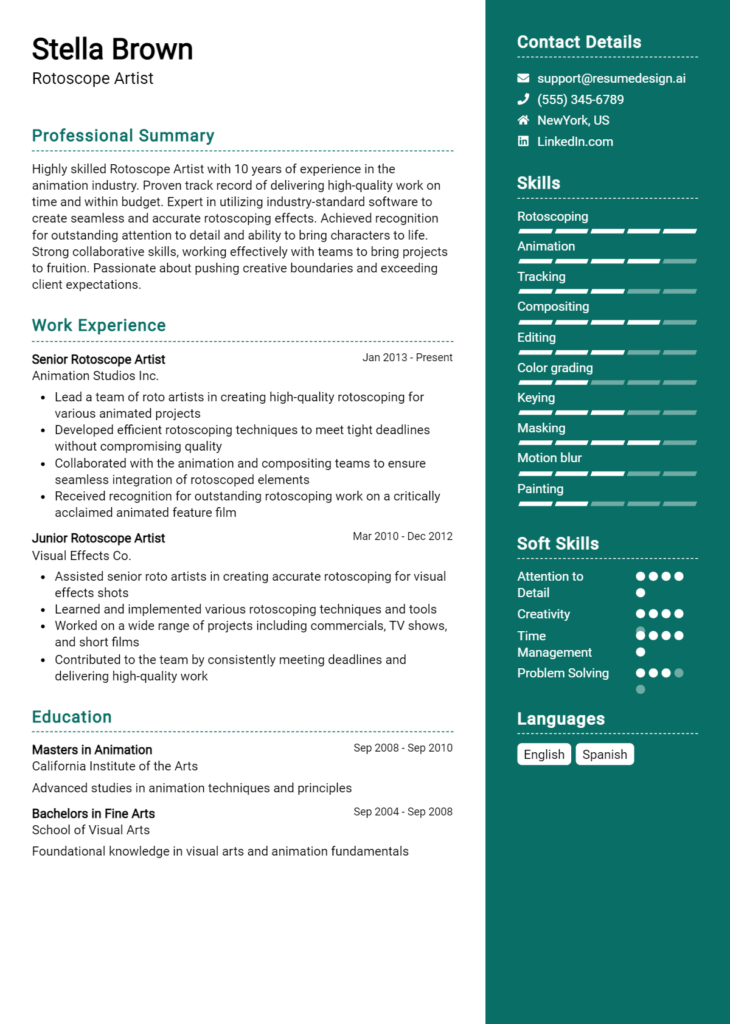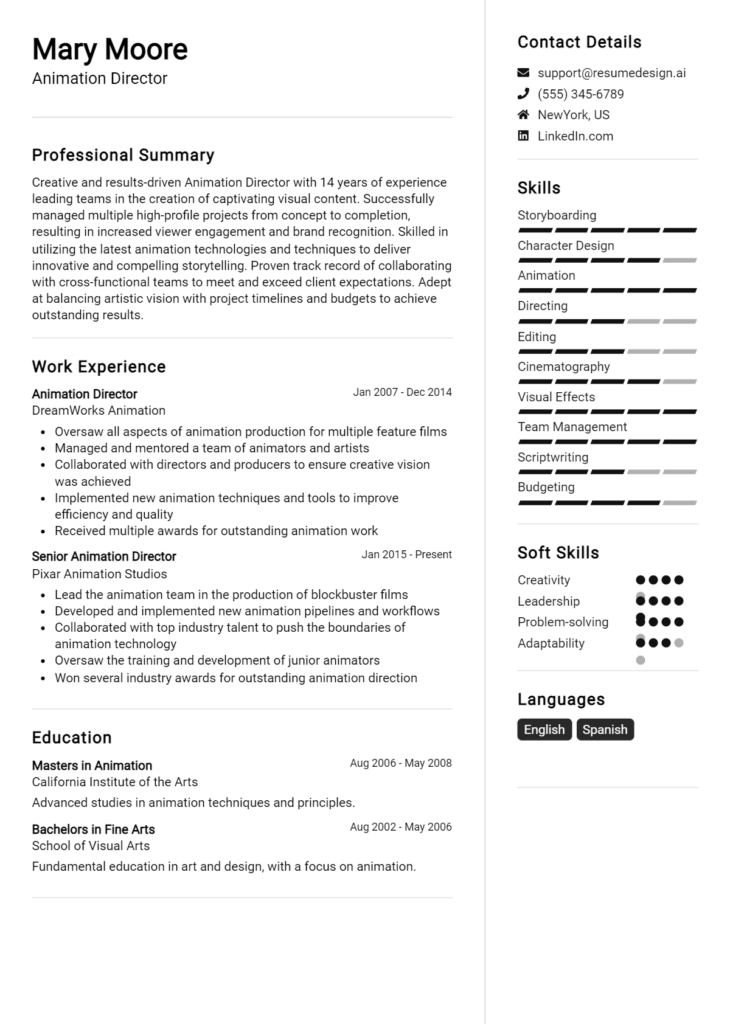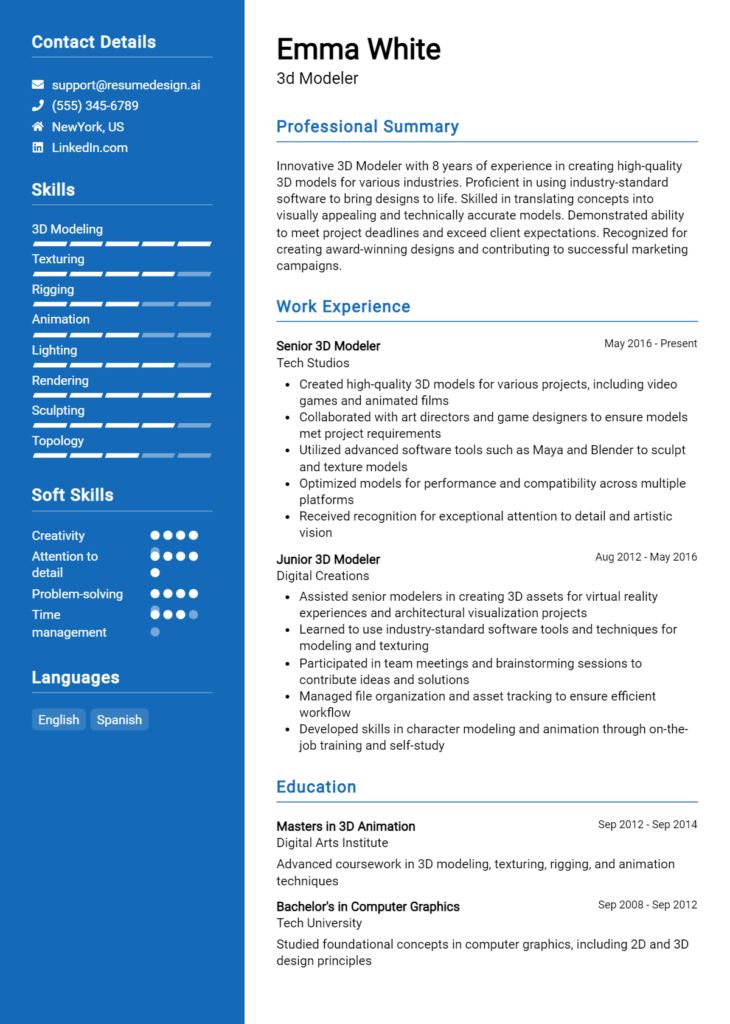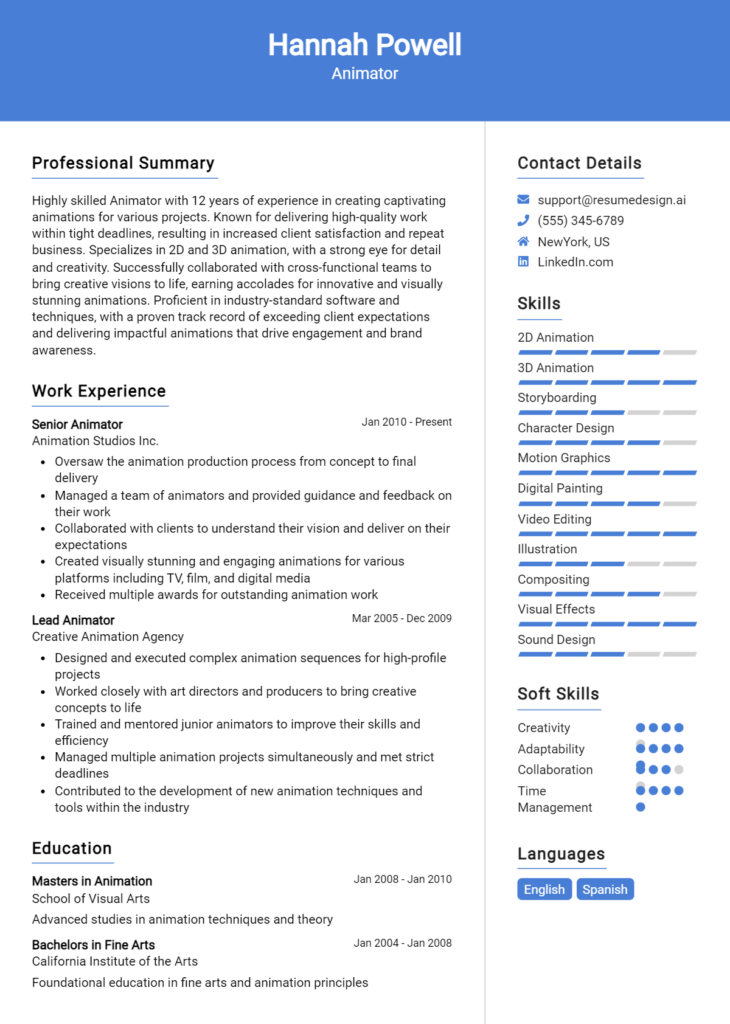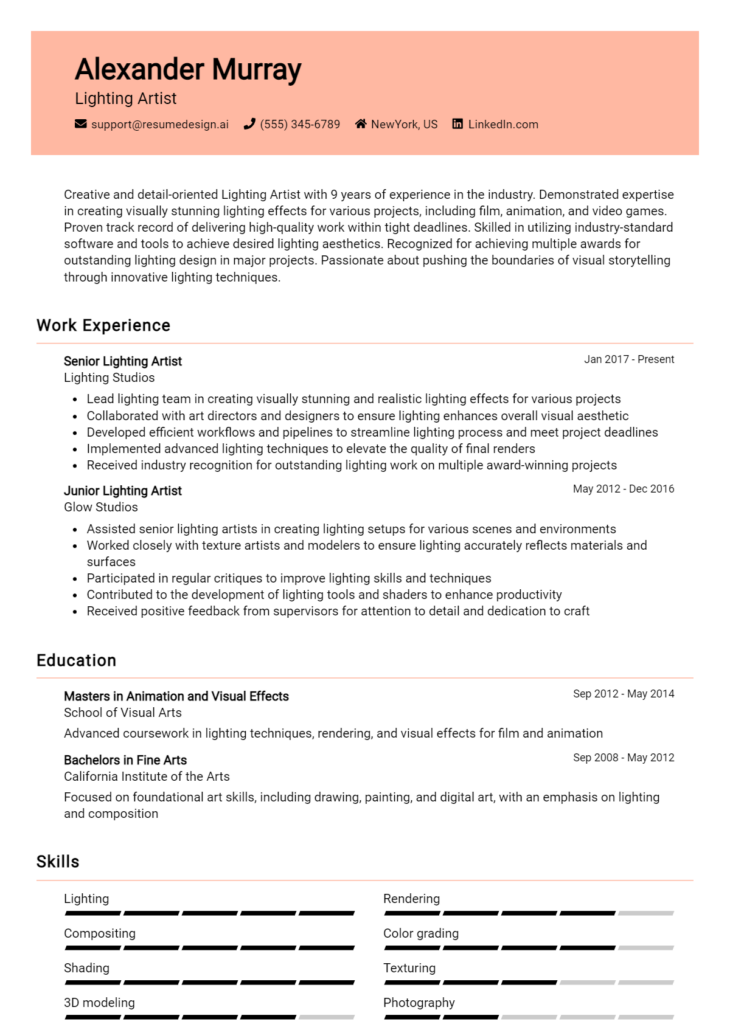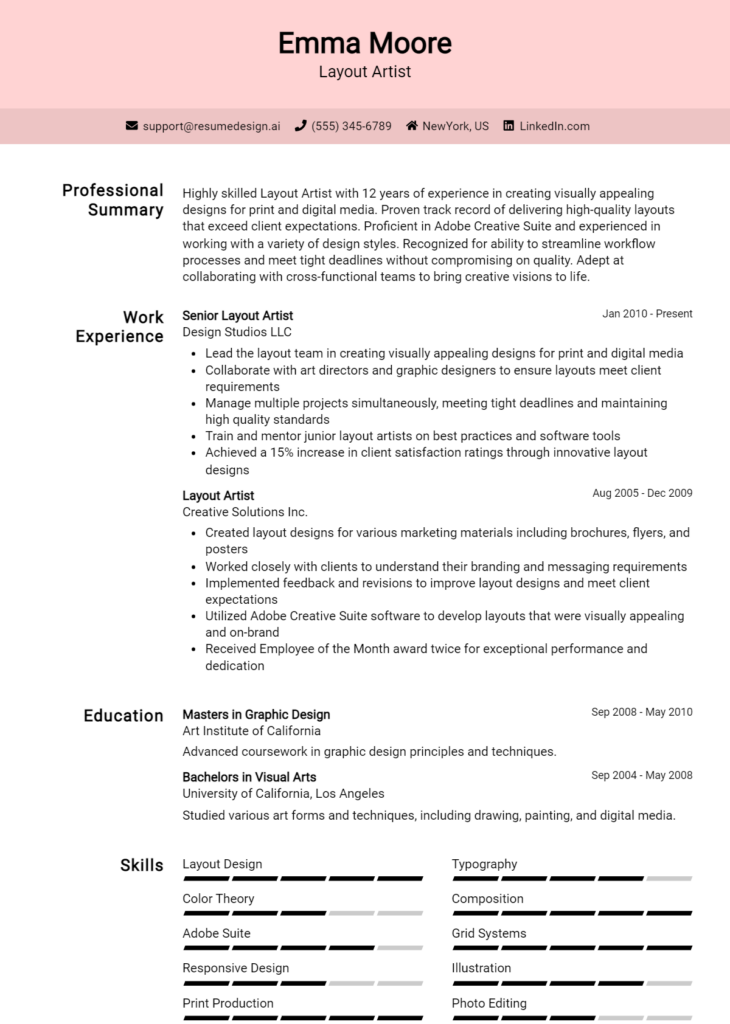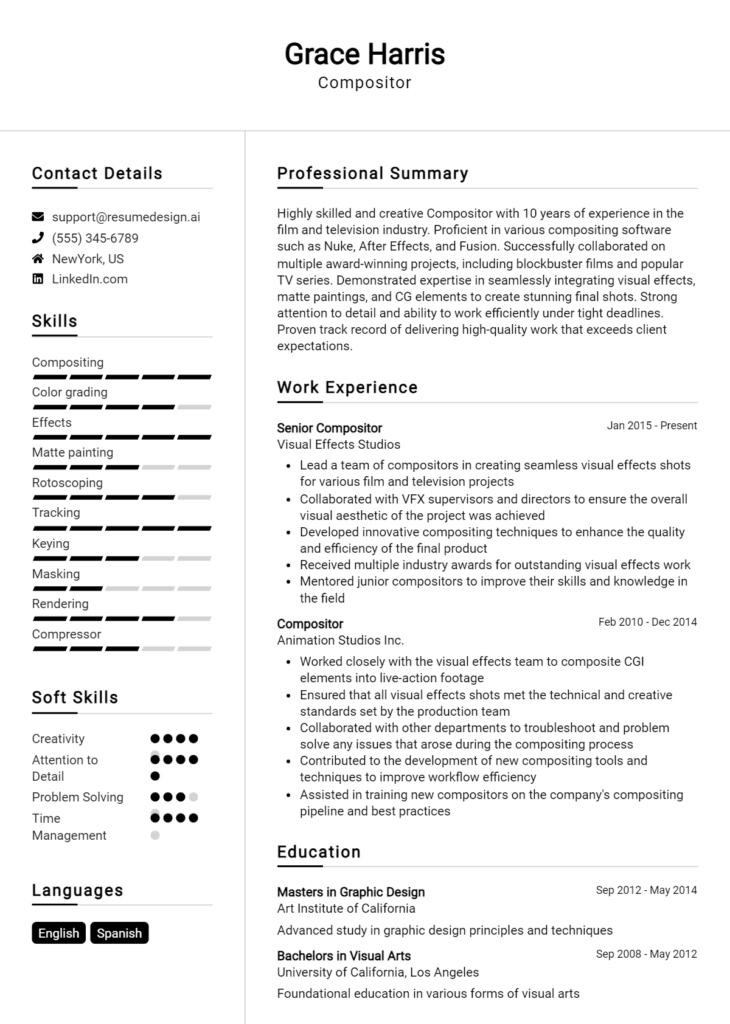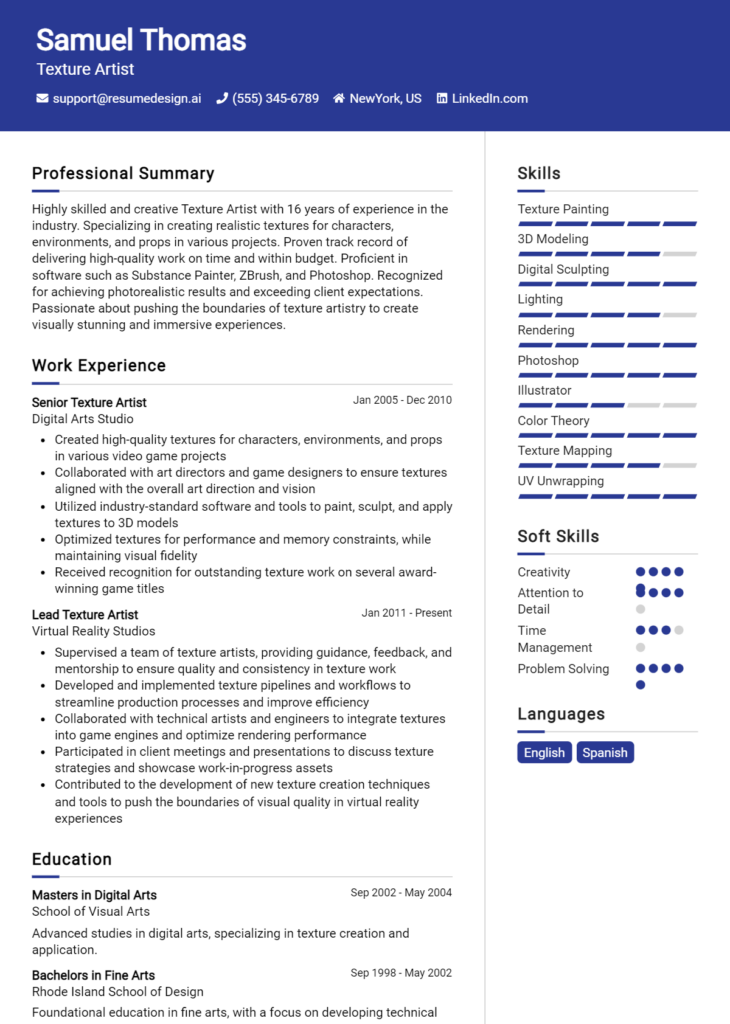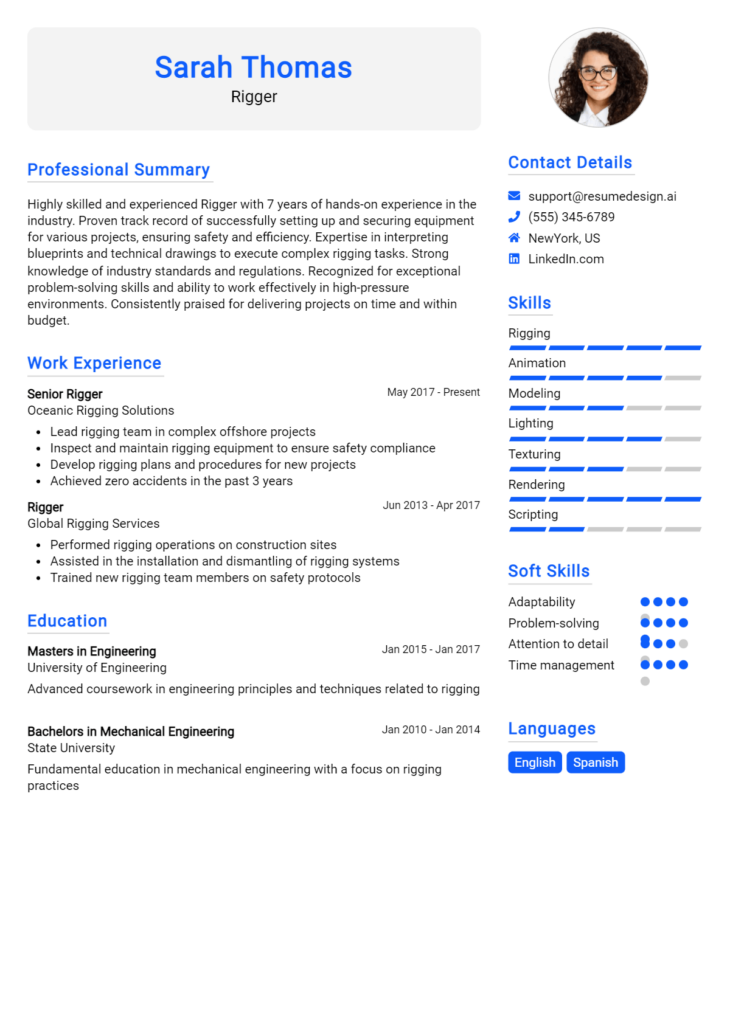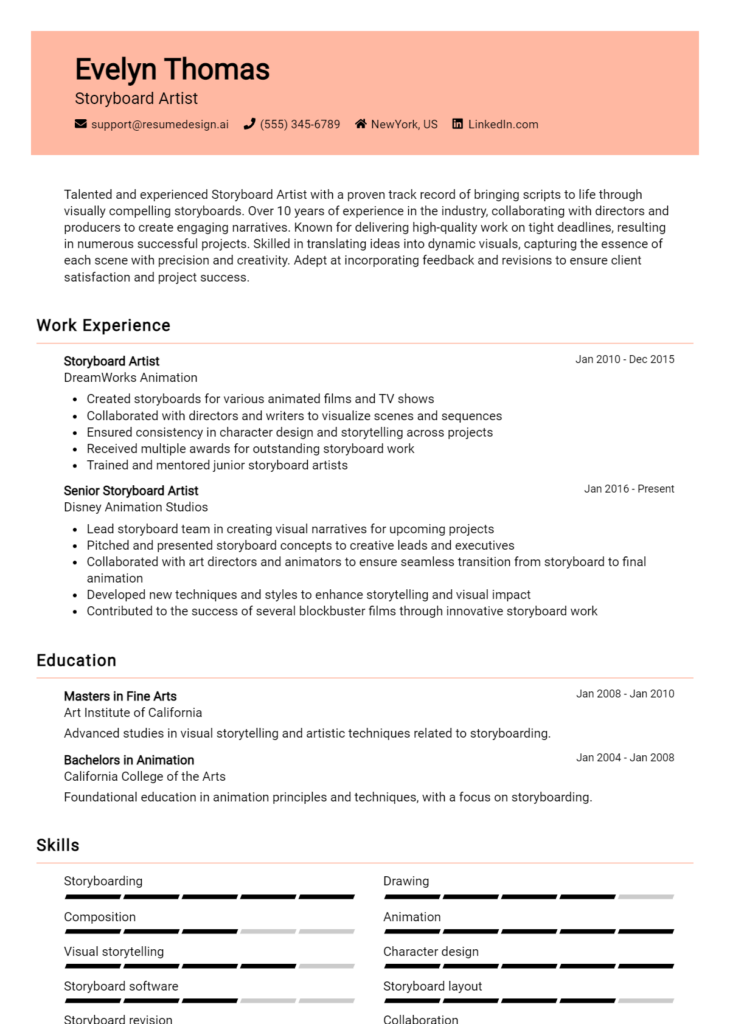Character Designer Core Responsibilities
A Character Designer plays a crucial role in the development of visual narratives by creating original characters that resonate with the audience. Key responsibilities include conceptualizing character designs, collaborating with writers and animators, and iterating on designs based on feedback. Essential skills encompass strong artistic abilities, proficiency in design software, and problem-solving skills to address creative challenges. These competencies are vital in aligning character designs with organizational goals, and a well-structured resume can effectively highlight these qualifications to potential employers.
Common Responsibilities Listed on Character Designer Resume
- Developing unique character concepts and visual styles
- Collaborating with the animation and writing teams
- Creating detailed character turnarounds and expressions
- Iterating designs based on feedback from directors and clients
- Maintaining consistency across character designs throughout the project
- Researching trends and cultural elements that inform character design
- Utilizing design software such as Adobe Creative Suite and 3D modeling tools
- Participating in brainstorming sessions to generate innovative ideas
- Creating character sheets and model packs for production use
- Ensuring designs align with project themes and target demographics
- Contributing to marketing materials featuring character designs
- Mentoring junior designers and providing artistic guidance
High-Level Resume Tips for Character Designer Professionals
In the competitive world of character design, a well-crafted resume is essential for making a strong first impression on potential employers. Your resume serves as a showcase of your artistic talents, technical skills, and unique creative vision, all of which are crucial for landing your dream job. It’s not just a summary of your work history; it’s a reflection of your achievements and your ability to contribute to a project. This guide will provide practical and actionable resume tips specifically tailored for Character Designer professionals, helping you to present your best self on paper.
Top Resume Tips for Character Designer Professionals
- Tailor your resume to the job description by incorporating relevant keywords and phrases that match the specific requirements of the role.
- Showcase your relevant experience by focusing on projects that align closely with the type of character design work the employer is seeking.
- Quantify your achievements by providing concrete examples, such as the number of characters designed for a project or the impact of your designs on user engagement.
- Highlight industry-specific skills such as proficiency in software like Adobe Creative Suite, Blender, or ZBrush that are crucial for character design.
- Include a strong portfolio link that showcases a variety of your best work, emphasizing your versatility and creativity in character design.
- Utilize a clean and visually appealing layout that reflects your design sensibility and makes your resume easy to read.
- Incorporate testimonials or quotes from previous employers or collaborators to add credibility and highlight your teamwork skills.
- Focus on your educational background in art, design, or a related field to emphasize your formal training and understanding of design principles.
- Consider adding a section for relevant certifications or workshops that further demonstrate your commitment to professional development in character design.
By implementing these tips, you can significantly enhance your resume's effectiveness, increasing your chances of standing out and landing a position in the character design field. A polished and tailored resume not only showcases your skills and achievements but also communicates your passion and dedication to your craft, making you a more attractive candidate to potential employers.
Why Resume Headlines & Titles are Important for Character Designer
In the competitive field of character design, a well-crafted resume headline or title serves as the first impression a hiring manager has of a candidate. A strong headline can immediately grab attention, summarizing key qualifications and unique strengths in one impactful phrase. This concise, relevant title not only highlights a candidate's suitability for the role but also sets the tone for the rest of the resume. By strategically incorporating specific skills or achievements, a powerful resume headline can distinguish a candidate from the crowd and lay the groundwork for a compelling application.
Best Practices for Crafting Resume Headlines for Character Designer
- Keep it concise—aim for one to two impactful phrases.
- Make it role-specific to clearly indicate your professional focus.
- Highlight key skills or areas of expertise relevant to character design.
- Use action verbs or strong adjectives to convey confidence and creativity.
- Incorporate industry-specific keywords that align with the job description.
- Avoid generic phrases; personalize your headline to reflect your unique experience.
- Include measurable achievements when possible to demonstrate impact.
- Ensure it aligns with the overall theme and content of your resume.
Example Resume Headlines for Character Designer
Strong Resume Headlines
"Award-Winning Character Designer Specializing in 3D Animation and Visual Storytelling"
“Creative Character Artist with 7 Years of Experience in Game Development and Concept Art”
“Innovative Character Designer with Expertise in Diverse Styles and Engaging Storytelling”
Weak Resume Headlines
“Character Designer Looking for Opportunities”
“Experienced Designer”
Strong headlines are effective because they immediately communicate the candidate's strengths and specific areas of expertise, capturing the attention of hiring managers. They utilize relevant keywords and showcase accomplishments that resonate with the job requirements. In contrast, weak headlines fail to impress due to their vagueness and lack of specificity, making it difficult for employers to gauge the candidate's true potential and fit for the role. By avoiding generic phrases, candidates can enhance their visibility and appeal in a crowded job market.
Writing an Exceptional Character Designer Resume Summary
A resume summary is a critical component for a Character Designer, as it serves as the first impression a hiring manager will have of a candidate. A well-crafted summary quickly captures attention by showcasing key skills, relevant experience, and notable accomplishments in the field. Given the competitive nature of the creative industry, it is essential that this summary is concise, impactful, and tailored specifically to the job being applied for. A strong resume summary not only highlights a candidate's unique qualifications but also sets the tone for the rest of the application, making it a vital element in securing an interview.
Best Practices for Writing a Character Designer Resume Summary
- Quantify achievements to demonstrate impact and effectiveness.
- Focus on relevant skills that align with the job description.
- Tailor the summary to reflect the specific requirements of the position.
- Use strong action verbs to convey confidence and proactivity.
- Showcase a mix of creative and technical skills relevant to character design.
- Keep it concise, ideally between 2-4 sentences.
- Avoid jargon or overly complex language; clarity is key.
- Highlight soft skills, such as collaboration or communication, that enhance teamwork.
Example Character Designer Resume Summaries
Strong Resume Summaries
Innovative Character Designer with over 5 years of experience in creating engaging and memorable characters for animated series. Successfully led a team of designers in developing a character lineup that increased viewer engagement by 30% in the first season.
Detail-oriented Character Designer proficient in Adobe Creative Suite and 3D modeling software, with a proven track record of designing characters that resonate with audiences. Designed over 40 unique characters for a AAA video game, enhancing user experience and received a Game Design Award.
Creative Character Designer with expertise in both 2D and 3D art, recognized for a collaborative approach that fosters innovation. Spearheaded a project that reduced design turnaround time by 25% while maintaining high-quality standards, contributing to the successful launch of a new animated feature.
Weak Resume Summaries
I am a Character Designer with experience and skills in design.
Creative professional looking for opportunities in character design and animation.
The strong resume summaries stand out because they quantify achievements, highlight specific skills, and directly relate to the role of a Character Designer, presenting concrete examples of success. In contrast, the weak summaries lack detail, provide no measurable outcomes, and fail to convey relevant skills or experience, making them less effective in capturing the attention of hiring managers.
Work Experience Section for Character Designer Resume
The work experience section of a Character Designer resume is a critical component that highlights a candidate's technical skills, creativity, and ability to collaborate effectively within teams. It serves as a showcase for the designer's past roles, responsibilities, and contributions to projects, demonstrating how they have successfully delivered high-quality character designs that meet industry standards. Additionally, quantifying achievements—such as the number of characters designed, the impact on project timelines, or improvements in user engagement—can significantly enhance the perceived value of a candidate’s experience. Aligning this section with industry expectations further underscores the candidate’s readiness to tackle new challenges in the character design field.
Best Practices for Character Designer Work Experience
- Highlight specific software and tools used (e.g., Adobe Creative Suite, ZBrush).
- Include quantifiable results, such as the number of projects completed or improvements made.
- Demonstrate technical expertise by detailing the design processes employed.
- Showcase collaboration efforts by mentioning teamwork and cross-departmental projects.
- Use action verbs to convey initiative and impact in your roles.
- Align experience descriptions with industry standards and expectations.
- Tailor your experiences to the job description to enhance relevancy.
- Incorporate feedback from team members or clients to show successful project outcomes.
Example Work Experiences for Character Designer
Strong Experiences
- Designed over 50 unique character models for a AAA video game, resulting in a 30% increase in player engagement based on feedback and analytics.
- Led a team of 5 designers in developing character concepts for an animated series, successfully meeting all deadlines and maintaining a 95% satisfaction rate from stakeholders.
- Implemented a new design workflow that reduced character development time by 20%, allowing for more iterations and creative exploration.
- Collaborated with writers and animators to create cohesive character arcs, receiving commendation from the production team for enhancing narrative depth.
Weak Experiences
- Worked on character designs for various projects.
- Assisted in the design process and contributed to team discussions.
- Helped with character modeling and editing.
- Participated in multiple projects across different genres.
The examples labeled as strong showcase specific achievements, technical leadership, and successful collaboration, which are essential for a Character Designer's role. They provide clear, quantifiable outcomes and highlight the designer's contributions to projects, making them compelling to potential employers. In contrast, the weak experiences lack detail and specificity, failing to convey the candidate's true capabilities and impact, which diminishes their overall effectiveness in the resume.
Education and Certifications Section for Character Designer Resume
The education and certifications section of a Character Designer resume is crucial as it underscores the candidate's academic foundation, industry-relevant credentials, and commitment to continuous learning. This section not only showcases the educational qualifications that have equipped the candidate with essential skills in character design but also highlights any specialized training and certifications that align with industry standards. By providing relevant coursework, certifications, and evidence of ongoing professional development, candidates can significantly enhance their credibility and demonstrate their readiness for the role, making them more attractive to potential employers.
Best Practices for Character Designer Education and Certifications
- Include degrees from accredited institutions related to art, design, or animation.
- List industry-recognized certifications, such as those from Adobe or other relevant software platforms.
- Highlight specialized training programs that focus on character design or related fields.
- Provide relevant coursework that directly pertains to character design techniques and methodologies.
- Use clear and concise formatting for easy readability, emphasizing key achievements.
- Keep the information up to date, removing outdated qualifications that no longer reflect your skills.
- Consider including workshops or seminars attended that showcase commitment to skill enhancement.
- Align educational experiences with job descriptions to demonstrate relevance to potential employers.
Example Education and Certifications for Character Designer
Strong Examples
- Bachelor of Fine Arts in Animation, Rhode Island School of Design, 2020
- Certified Adobe Illustrator Expert, 2021
- Character Design Workshop, Gnomon School of Visual Effects, 2022
- Coursework in Digital Character Modeling, Savannah College of Art and Design, 2019
Weak Examples
- Associate Degree in General Studies, Local Community College, 2015
- Certificate in Basic Computer Skills, 2016
- High School Diploma, 2010
- Attended a seminar on Graphic Design, 2018 (no certification obtained)
The strong examples are considered effective because they demonstrate relevant education and specialized training directly applicable to the role of a Character Designer. They reflect the candidate's qualifications and commitment to the field, showcasing both formal education and industry-recognized certifications. In contrast, the weak examples are less impactful as they include generic or outdated qualifications that do not align with the specific skills and knowledge required for character design, making them less relevant to potential employers in this competitive field.
Top Skills & Keywords for Character Designer Resume
In the competitive field of character design, showcasing the right skills on your resume is crucial for standing out to potential employers. A well-crafted resume not only highlights your artistic abilities but also reflects your understanding of industry standards and collaborative capabilities. By emphasizing both hard and soft skills, you can demonstrate your versatility and readiness to contribute to a creative team. The right combination of these skills can convey your proficiency in design software, your ability to communicate ideas effectively, and your adaptability to various project requirements. For more insights into essential skills and how to frame your work experience, consider the following lists of top skills necessary for a successful character designer.
Top Hard & Soft Skills for Character Designer
Soft Skills
- Creativity
- Communication
- Teamwork
- Problem-solving
- Adaptability
- Time management
- Attention to detail
- Open-mindedness
- Empathy
- Critical thinking
- Collaboration
- Flexibility
- Patience
- Leadership
- Self-motivation
- Positive attitude
- Networking
- Active listening
Hard Skills
- Proficiency in Adobe Creative Suite (Photoshop, Illustrator)
- 3D modeling skills (Maya, Blender)
- Understanding of anatomy and proportions
- Knowledge of color theory
- Experience with character rigging
- Storyboarding
- Concept art creation
- Familiarity with animation principles
- Digital painting techniques
- Graphic design fundamentals
- Character turnaround sheets
- Knowledge of typography
- Visual storytelling
- Familiarity with game engines (Unity, Unreal Engine)
- Traditional drawing and sketching
- Understanding of user experience (UX) design
- Ability to take constructive feedback
- Portfolio development and presentation skills
Stand Out with a Winning Character Designer Cover Letter
Dear [Hiring Manager's Name],
I am excited to apply for the Character Designer position at [Company Name], as advertised on [Job Listing Source]. With a background in animation and a passion for storytelling through character design, I believe I would be a valuable addition to your creative team. My experience collaborating with artists and writers has equipped me with the skills to bring unique and memorable characters to life, aligning perfectly with your vision for innovative storytelling.
In my previous role at [Previous Company Name], I successfully designed a diverse range of characters for animated series, ensuring each one resonated with audiences while maintaining the narrative's core themes. I utilized various design techniques, including 2D and 3D modeling, to create characters that were not only visually appealing but also had depth and personality. I thrive on feedback and iteration, allowing me to refine my designs until they capture the essence of the story and engage viewers emotionally.
I am particularly drawn to [Company Name] because of its commitment to pushing creative boundaries and developing characters that inspire and entertain. I admire your recent project, [Specific Project or Character], and I would love the opportunity to contribute my skills in developing characters that leave a lasting impact. I am proficient in industry-standard software such as Adobe Creative Suite and Blender, and I continuously seek to expand my skill set by exploring new techniques and trends in character design.
Thank you for considering my application. I am eager to bring my creativity and passion for character design to [Company Name] and collaborate with your talented team. I look forward to the opportunity to discuss how my background and vision align with your goals for the upcoming projects.
Sincerely,
[Your Name]
[Your Contact Information]
[Your Portfolio Link]
Common Mistakes to Avoid in a Character Designer Resume
When crafting a resume as a Character Designer, it's essential to present your skills and experiences in a way that resonates with potential employers. However, many applicants fall into common pitfalls that can undermine their chances of landing an interview. By being aware of these mistakes, you can create a more compelling resume that highlights your creativity and professionalism. Here are some common mistakes to avoid:
Neglecting a Portfolio Link: Failing to include a link to your portfolio can be detrimental. Your work is your best advertisement, and employers want to see examples of your character designs.
Overloading with Text: A resume cluttered with lengthy descriptions can be overwhelming. Use concise bullet points to highlight key achievements and skills instead.
Ignoring Tailoring for Specific Roles: Submitting a generic resume can make you appear uninterested. Tailor your resume for each job by emphasizing the skills and experiences that align with the job description.
Lack of Relevant Keywords: Many companies use Applicant Tracking Systems (ATS) to filter resumes. Failing to include relevant industry keywords can lead to your resume being overlooked.
Poor Visual Presentation: As a character designer, your resume should reflect your artistic skills. Avoid unprofessional fonts or layouts that detract from your creative abilities.
Inadequate Experience Details: Simply listing your past jobs isn’t enough. Provide context for your roles, focusing on your contributions and the impact of your work on projects.
Forgetting to Proofread: Spelling and grammatical errors can give a poor impression. Always proofread your resume to ensure professionalism and attention to detail.
Omitting Soft Skills: Character design is not just about technical skills. Highlight soft skills like teamwork, communication, and creativity, which are vital in collaborative environments.

